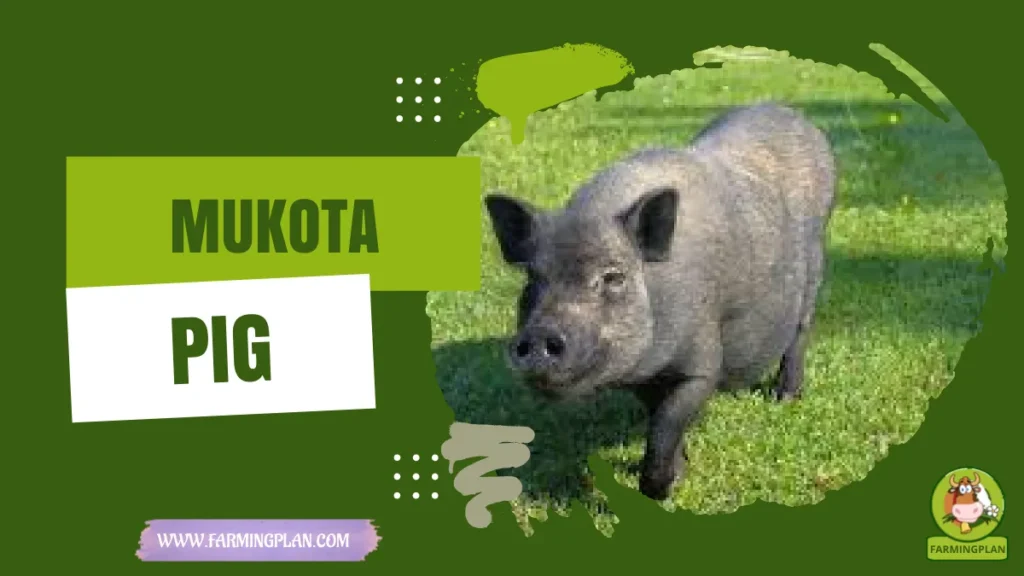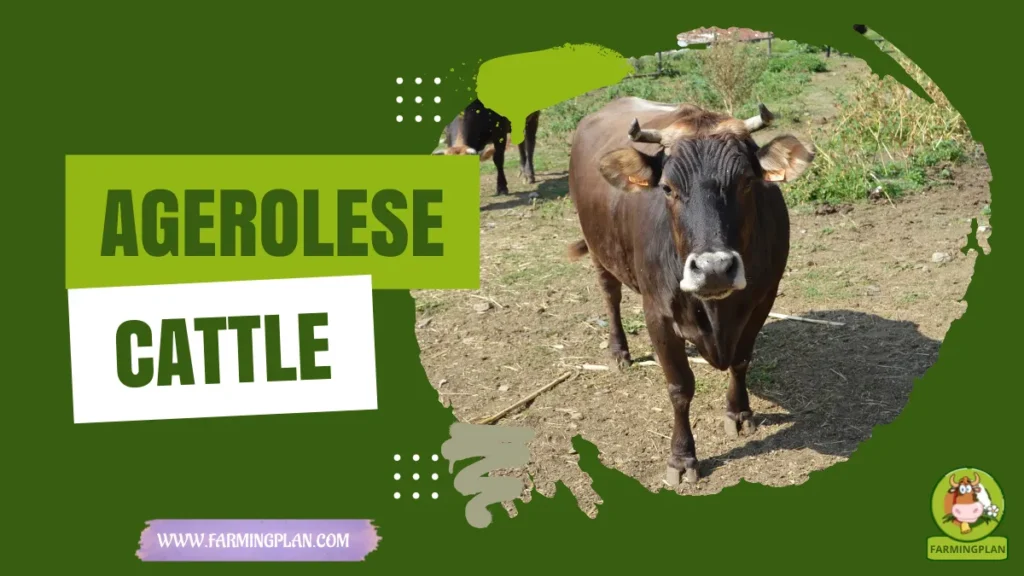Aberdeen Angus Cattle are one of today’s most popular and trusted breeds. Known for their rich black color and high-quality beef, these cattle are a top choice for farmers, breeders, and ranchers. Many American cattle producers love them because they are easy to handle, grow fast, and adapt to weather conditions. Whether you’re a beginner or someone with a private herd, learning about Aberdeen Angus can help you make wise choices in the cattle business. In this guide, we’ll walk you through everything from their history and care to expert tips that make raising them successful. Let’s dive into the world of these fantastic black cattle!
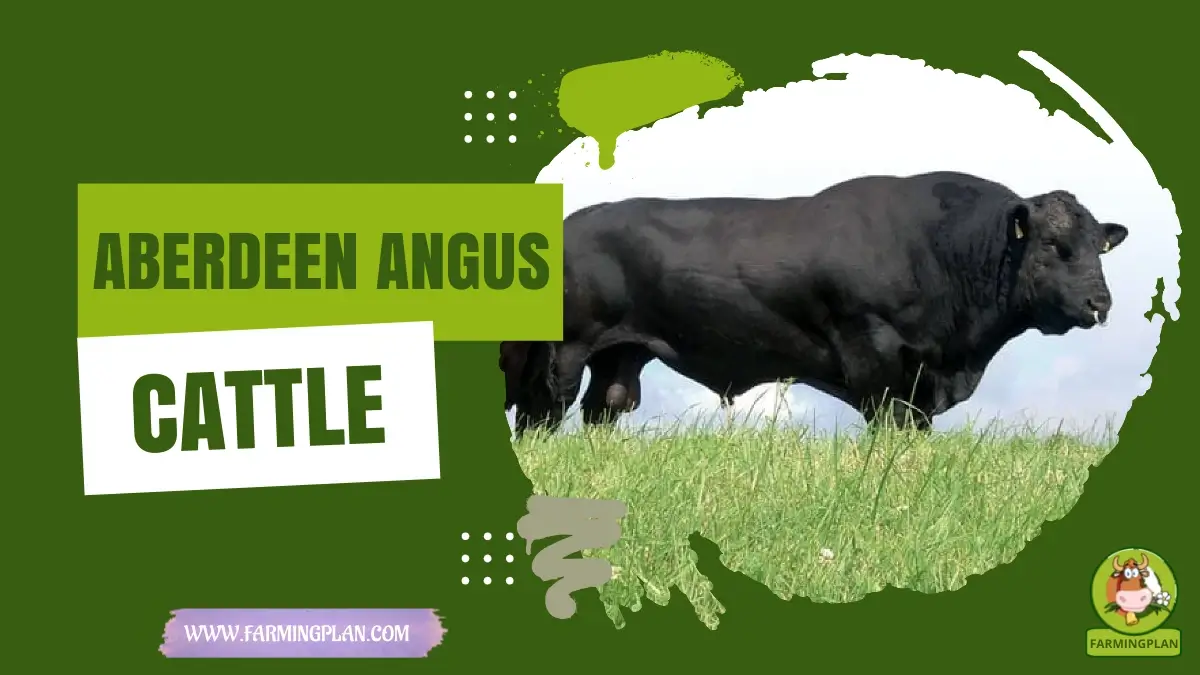
History & Origin of Aberdeen Angus Cattle
The Aberdeen Angus Cattle, with its rich history and origin dating back to the 18th century in the historic province of Aberdeen, Scotland, commands respect and admiration. Farmers in this region bred strong, hornless black cattle known for their hardiness and meat quality. These cattle became the foundation of what would later become one of the most trusted breeds of cattle in the world.
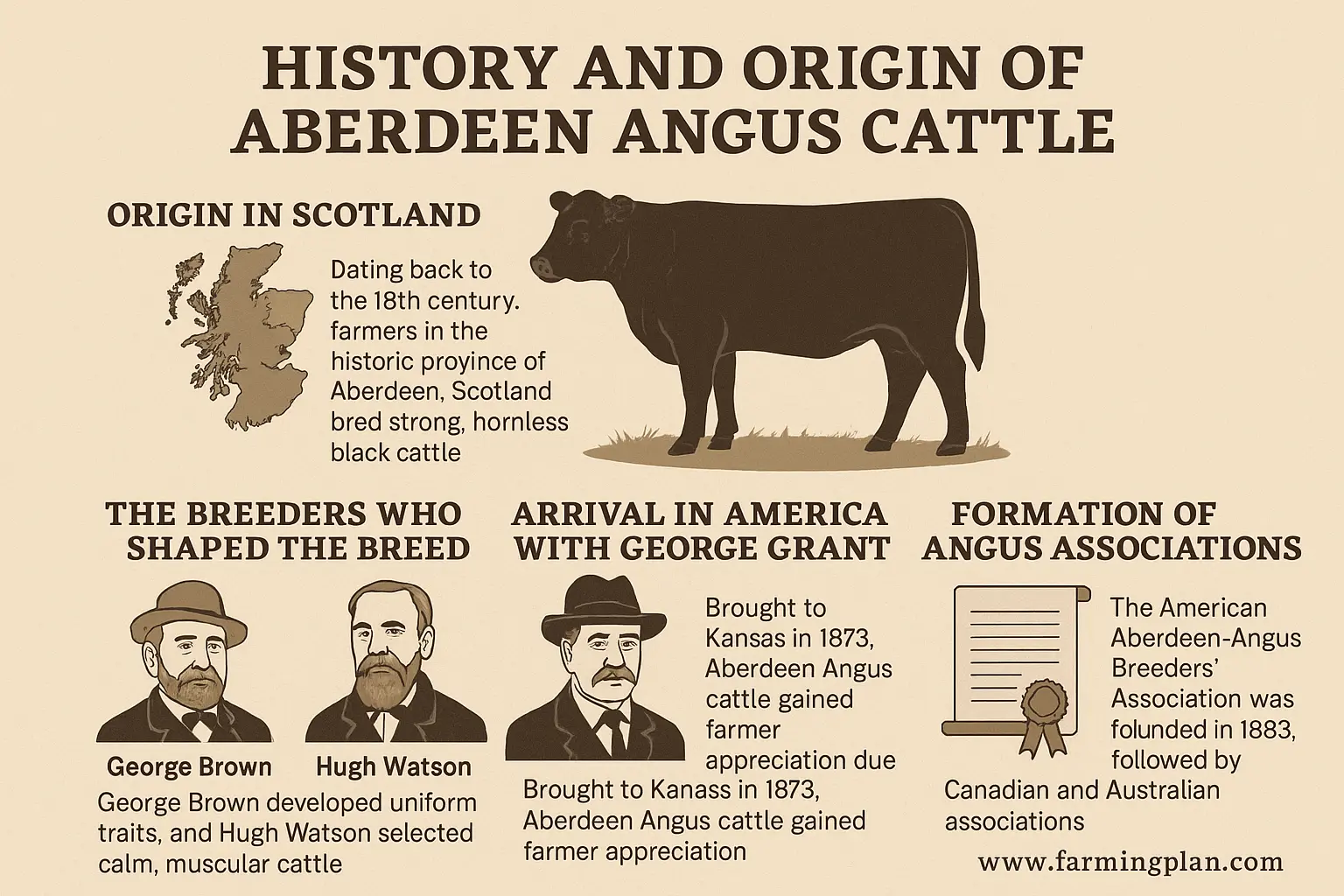
The Breeders Who Shaped the Breed
In the 19th century, two breeders stood out—George Brown and Hugh Watson. Brown, based in Watertown, focused on developing uniform traits, while Watson selected calm, muscular, and efficient cattle that gained weight. Their work gave birth to what is now called the Aberdeen-Angus breed.
Read More: Anatolian Black Cattle: Successful Farming
Arrival in America with George Grant
Aberdeen Angus cattle arrived in the United States in 1873 through the dedication of Scottish immigrant George Grant. They came with George Grant in Kansas in 1873, but quickly gained farmer appreciation because of their distinctive character traits. The breed showed excellent survival against harsh weather and lacked horns, thus creating greater ease of handling.
Formation of Angus Associations
American breeders improved the popularity of Aberdeen-Angus cattle, forming the American Aberdeen-Angus Breeders’ Association in 1883. After its formation, the group evolved into the American Angus Association, a vital institution dedicated to breeding Angus standards and offering farmers breeding resources and organizational support. The Canadian Angus Association and Angus Australia uphold similar functions to enable farmers worldwide to rear robust Angus cattle.
Read More: American Angus Cattle: Farm From Scratch
Characteristics of Aberdeen Angus Cattle
One of the most well-known traits of Aberdeen Angus Cattle is that they are naturally hornless cattle. This makes them safer and easier to handle, especially for cattle producers and beginners. Most of these cattle are solid black, named Black Angus. While black is the dominant color, there are also colored animals like Red Angus, which are recognized but less common.
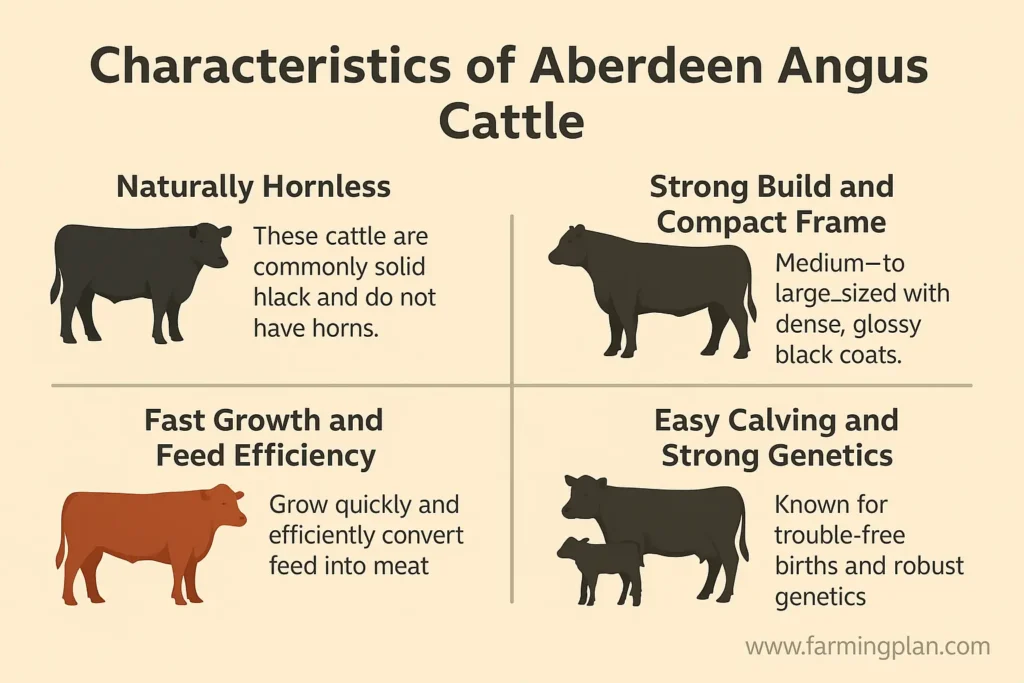
Strong Build and Compact Frame
These medium- to large-sized beef cattle are strong and muscular. Their dense and glossy black stock helps protect them from sunburn and harsh weather conditions. They grow fast, and their bodies are built to convert food into meat efficiently, making them a top choice in beef production.
Fast Growth and Feed Efficiency
Aberdeen Angus cattle are loved for their excellent feed efficiency. They gain weight quickly and grow well even on grain-based diets, helping cattle breeders save money and get better returns. Their ability to grow on grass and grain makes them perfect for commercial stock and small farms.
Easy Calving and Strong Genetics
Another big plus is their reputation for easy calving. This means fewer problems during birth and is safer for the cow and calf. Their genomic-enhanced expected progeny differences (GE-EPDs) help breeders choose animals with strong, healthy traits for future herds. These strong genetics, which can be identified through GE-EPDs, make them a top pick for those raising cattle for generations, as they ensure the continuation of desirable traits and the herd’s overall health.
Read More: Angus Cattle: A Scottish Breed of Cattle
Nature & Temperament of Aberdeen Angus Cattle
Aberdeen Angus Cattle are known for their calm and friendly nature. They are often called natural cattle because they are easy to work with and don’t spook easily. This makes them an excellent choice for acreage farmers, beginners, and families raising cattle for 4-H and other youth projects.
Good Behavior in Herds
These cattle are peaceful and get along well with others in a private herd or larger group. They are not aggressive and rarely fight, which helps reduce injuries and stress. Their calm behavior also makes daily care and animal handling easier and safer for owners.
Adaptable to Weather and Environment
Aberdeen Angus is well-suited to many climates, which should reassure and instill confidence in farmers. They adjust easily whether they live in open winter ranges or warmer areas. Their black coat protects them from cold winds, and their sturdy bodies help them handle dramatic weather conditions better than many other cattle breeds.
Perfect for Long-Term Cattle Raising
Their strong genes, calm personality, and easy care needs make them a top pick for those raising cattle for generations. Whether you’re just starting or expanding a herd, their steady nature makes the whole process smoother.
Food & Diet of Aberdeen Angus Cattle
Aberdeen Angus Cattle grow well on a pasture-based diet. They love fresh grass, and many cattle producers raise them on open fields where they graze freely. This helps them build strong muscles and keeps their meat high in quality. Farmers often say, “Healthy grass leads to healthy beef.”
Grain Diets for Finishing
Many cattle breeders finish Angus on grain diets for better marbling and tenderness in beef. Grains like corn, barley, and wheat give the animals more energy. This phase usually happens before the cattle go to market and helps produce the famous flavor of Angus Beef that people love.
Balanced Nutrition Matters
Good nutrition is key to raising healthy Aberdeen Angus cattle. Their diet must include the right mix of protein, fiber, and minerals. Some farmers add salt blocks, mineral tubs, or special feed blends to support animal growth and prevent sickness.
Foods to Avoid
There are some things Angus cattle should not eat. Moldy hay, rotting plants, or spoiled grains can harm their health. Too much grain without enough fiber may also upset their stomachs. Farmers should always check feed quality to protect their herd.
“From The Rolling Hills Of Scotland To Global Farms, Aberdeen Angus Cattle Deliver Excellence In Every Bite Of Angus Beef—quality You Can Taste, Reliability You Can Trust.”
Usage & Purpose of Aberdeen Angus Cattle
Aberdeen Angus Cattle ranks as a global leader in meat production. People value Angus beef because it provides delicious meat with excellent marbling and tender texture. People commonly find Angus Beef available in stores and restaurants. The cattle industry trusts Aberdeen Angus Cattle for their high quality, which leads to consumer preference.
Perfect Fit for Commercial and Small Farms
These cattle are a smart pick for both commercial cattlemen and small-scale farmers. Their fast growth, feed efficiency, and calm nature make them easy to raise and manage. Many progressive cattlemen rely on this breed to grow their businesses and meet consumer demand.
Ideal for Youth and 4-H Projects
Because of their friendly temperament and manageable size, Aberdeen Angus is an excellent fit for 4-H and other youth projects. Young cattle handlers enjoy working with them because they’re less likely to act out and easier to train.
Valuable for Breeding Programs
The Aberdeen-Angus breed plays a significant role in cattle breeding. Their genetics help improve other cattle strains, especially meat quality and birth ease. Crossbreeding cattle with Angus leads to black calves with better market value.
Special Features of Aberdeen Angus Cattle
One of the most helpful traits of Aberdeen Angus Cattle is that they are naturally hornless. This makes them safer for herd farmers, handlers, and other animals. You won’t need to dehorn them, which reduces stress and injuries.
Strong Feed-to-Meat Conversion
These cattle are known for their high feed efficiency, meaning they convert food into body weight faster than many other cattle breeds. This leads to quicker growth and better results, especially beef cattle raised for profit.
High Consumer Demand for Angus Beef
Angus Beef is one of the most recognized names in the beef world. Thanks to its juicy flavor and tenderness, it brings strong consumer acceptance and high prices. This makes Aberdeen Angus a top pick for farmers looking to meet market needs.
Excellent Calving and Mothering
Aberdeen Angus cows are known for easy calving and strong maternal instincts. They care well for their calves and have fewer birthing problems. This means healthier calves and less work for the farmer.
Adaptable to Many Environments
Cattle from this breed can successfully inhabit North American winter zones and South African agricultural areas. The cattle’s black coat layer protects against freezing temperatures, and their sturdy physique supports them during severe climate shifts.
Health Issues & Prevention
Like all cattle breeds, Aberdeen Angus is prone to a few common health issues. Bloat is one of the most frequent problems when gas builds up in the stomach. Sudden changes in diet or overeating can cause this. Monitoring their feed intake and making gradual changes is essential to prevent this.
Parasite Control
External and internal parasites such as worms and lice can affect Aberdeen Angus cattle. Regular deworming and parasite control are essential for keeping them healthy. Using the proper medications and keeping their living areas clean can help prevent infections and strengthen their immune systems.
Foot Health and Hoof Care
The health of Aberdeen Angus cattle depends strongly on correct hoof care methods. The preventive care of hoof infections alongside easy foot movement results from regular trimming procedures. Lameness conditions triggered by inadequate hoof attention will affect the cattle’s growth patterns and reduce their feed efficiency.
Breathing and Respiratory Issues
Cattle, including Aberdeen Angus, can develop respiratory problems, especially if kept in poorly ventilated areas. Pneumonia is a common concern in younger cattle, particularly if stressed. Keeping their environment clean, dry, and well-ventilated will help reduce the risk of respiratory infections.
Preventive Care Tips
Keeping Aberdeen Angus cattle healthy requires regular vaccinations, balanced feeding, proper parasite control, and good hygiene. A veterinarian must help you develop specific health plans for your herd’s needs.
Step-by-Step Farming Guide for Aberdeen Angus Cattle
Raising Aberdeen Angus cattle includes building suitable conditions while choosing strong animals and feeding them properly. Firstly, offering clean water, extensive grazing areas, and appropriate housing facilities is crucial. Successful herd maintenance requires regular health checks, vaccinations, and proper hoof care because these steps directly contribute to herd health. Geographically, Aberdeen Angus cattle function best when their dietary needs include grasses, grains, and non-worrying living conditions. Tracking your cattle’s growth and calving evaluation will help you maintain high productivity while they live a healthy life.
Step 1: Set Up the Right Environment
Before bringing Aberdeen Angus cattle to your farm, ensure the environment is ideal for their needs. They thrive in open spaces with access to clean water, fresh grass, and shelter from extreme weather. Fencing should be sturdy and secure to prevent them from wandering.
Step 2: Select Healthy Cattle
When purchasing Aberdeen Angus cattle, always choose healthy animals. Look for cattle with no visible signs of disease, good body condition, and a calm demeanor. If you’re starting with calves, ensure they are from a reputable breeder with a strong herd book and track record.
Step 3: Introduce Them to the Herd
If you already have other cattle, introduce the Aberdeen Angus cattle slowly. This will help them acclimate to the new environment and reduce stress. Monitor their behavior for a few days to ensure they get along well with the rest of the herd.
Step 4: Provide a Balanced Diet
Feed your Aberdeen Angus cattle a balanced grass, hay, and grain diet. Fresh pasture should be their primary food source, but adding grain helps them grow faster and achieve the marbling that Angus Beef is known for. Don’t forget to provide mineral supplements, especially in winter when fresh grass is scarce.
Step 5: Regular Health Checks and Vaccinations
Keep your cattle healthy with regular check-ups. Vaccinate them against common diseases like bovine respiratory disease and keep them on a regular deworming schedule. Always keep their living space clean and dry to prevent infections and parasites.
Step 6: Maintain Hoof Care and Grooming
Trim the hooves of your Aberdeen Angus cattle regularly to prevent lameness. Routine grooming is also essential to keep their coat in good condition. This keeps them looking good and helps reduce the risk of skin infections and other health issues.
Step 7: Monitor for Calving
When your cows are ready to calve, monitor them closely. Aberdeen Angus cows are known for easy calving, but it’s essential to be prepared if assistance is needed. Have a safe, clean space for the cow to give birth, and keep the area quiet to avoid stress.
Step 8: Keep Track of Their Progress
Maintain records of your cattle’s health, breeding, and growth. This will help you identify issues early and improve your herd’s performance. You can also track their feed efficiency and growth rates, which will give you a better idea of how to maximize production.
Expert Tips & Best Practices
Start with high-quality breeding stock. Look for cattle with excellent genetics, good health, and desirable traits such as easy calving and feed efficiency. Reputable breeders can offer information about the cattle’s lineage and history, helping you build a strong herd.
Prioritize Feed Quality
Providing quality feed is key to the health and growth of Aberdeen Angus cattle. Invest in high-quality hay and pasture, and supplement with grains when needed. Proper nutrition boosts growth and improves meat quality, giving you better Angus Beef.
Monitor and Manage Stress Levels
Cattle are sensitive to stress, which impacts their growth and overall health. To reduce stress, avoid sudden changes in their environment or diet. Ensure they have enough space, and consider using calm handling techniques when working with them. The more relaxed your herd is, the healthier it will be.
Use Technology for Better Herd Management
Use modern tools like herd management software to track your Aberdeen Angus cattle’s growth, breeding, and health. These tools can help you make data-driven decisions to optimize production and reduce costs. Tracking key metrics like feed efficiency and calving rates can improve your herd’s performance.
Invest in Good Veterinary Care
Regular check-ups from a qualified veterinarian are essential for keeping your cattle in shape. A vet can help with vaccinations, parasite control, and identifying potential health issues before they become serious. Building a strong relationship with a vet will ensure your Aberdeen Angus herd stays healthy and productive.
FAQ
What are Aberdeen Angus cattle known for?
Aberdeen Angus cattle are renowned for their high-quality beef, which is characterized by fine marbling and tenderness. Their naturally polled (hornless) nature and solid black or red coat make them easily recognizable.
Where did Aberdeen Angus cattle originate?
Breeders like Hugh Watson developed these cattle in the early 19th century, from the counties of Aberdeenshire and Angus in northeastern Scotland.
Are Aberdeen Angus cattle easy to handle?
Yes, they are known for their docile temperament, making them easier to manage than other cattle breeds. This trait is beneficial for both farmers and handlers.
What is the typical weight of Aberdeen Angus cattle?
Adult Aberdeen Angus cows typically weigh around 650 kg, while bulls weigh up to 1,000 kg.
Are Aberdeen Angus cattle adaptable to different climates?
They are hardy and can adapt to various climates, thriving in hot and cold environments, contributing to their widespread popularity.
Conclusion
Aberdeen Angus cattle are a prized breed in the beef industry, celebrated for their high-quality meat, gentle temperament, and adaptability to various climates. Originating from Scotland, they have become a global standard for premium beef production. Their naturally polled nature and solid black or red coats make them easily identifiable. With a history of careful breeding and selection, Aberdeen Angus cattle remain a top choice for farmers and consumers, ensuring their place as a cornerstone of the beef industry.

